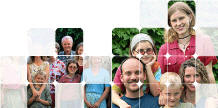|
Definition
The human spine consists of
the bony outer casing made up of segments of bone called vertebrae.
They protect the spinal cord which runs the inner length of the
spine. The spinal cord is like a mass of intertwined telegraph wires
which transmit nerve messages from the brain to various parts of the
body. They provide the initial stimulus from the brain for sensation
and movement.

Paraplegia and
Quadriplegia is permanent paralysis of the body caused by injury or
disease affecting the spinal cord.
Paraplegia involves a loss
of sensation and movement in the legs and in part or all of the
trunk. This varies according to the level of the injury. Generally,
the lower the injury, the less the loss of movement and sensation.
Paraplegia usually results from an injury to the spinal cord in the
mid and lower back.
Quadriplegia normally means
a loss of sensation and movement in all four limbs and the trunk.
This generally results from a spinal cord injury to the neck.
However, the loss of sensation and movement may not be complete with
some sensation and movement being retained in parts of the arms and
legs.
Another word
meaning Quadriplegia is Tetraplegia. Tetraplegia is the correct word
but Quadriplegia is more commonly used.
In pediatric practice, delay in starting to walk and difficulty in
walking are common problems. These conditions may indicate a
systemic disease (such as tickets), mental deficiency, or, more
commonly, some muscular or neurologic disease. Congenital cerebral
disease from periventricular leukomalacia accounts for a majority of
cases of infantile diplegia (weakness predominantly of the legs,
with minimal affection of the arms). Present at birth, it becomes
manifest in the first months of life and may appear to progress, but
actually the disease is stationary and the progression is only
apparent, being exposed as the motor system develops. Later there
may seem to be slow improvement as a result of the normal maturation
processes of childhood. Congenital malformation or birth injury of
the spinal cord are other possibilities. Friedreich ataxia and
familial paraplegia, Progressive muscular dystrophy, tumor and the
chronic varieties of polyneuropathy tend to appear later, during
childhood and adolescence, and are slowly progressive. Acute
transverse (demyelinative) myelitis is a rare condition of
childhood.

The effects of SCI depend on the type of injury and the level of
the injury. SCI can be divided into two types of injury - complete
and incomplete. A complete injury means that there is no function
below the level of the injury; no sensation and no voluntary
movement. Both sides of the body are equally affected. An incomplete
injury means that there is some functioning below the primary level
of the injury. A person with an incomplete injury may be able to
move one limb more than another, may be able to feel parts of the
body that cannot be moved, or may have more functioning on one side
of the body than the other. With the advances in acute treatment of
SCI, incomplete injuries are becoming more common.
The level of injury is very helpful in predicting what parts of the
body might be affected by paralysis and loss of function. Remember
that in incomplete injuries there will be some variation in these
prognoses.
When a SCI occurs, there is usually swelling of the spinal cord.
This may cause changes in virtually every system in the body. After
days or weeks, the swelling begins to go down and people may regain
some functioning. With many injuries, especially incomplete
injuries, the individual may recover with the GIGER MD ® Instruments
to such a degree, which appears unbelievable. In very rare cases,
people with spinal cord injury can regain almost all functioning
years after the injury.
In spinal cord injury, the spine is
normally damaged somewhere along its length. Thus it is said that
you have broken your back or neck. The bone in the spine will mend
as will other bones in the body when they are broken. However, the
nerve tissue in the spinal cord which is also damaged when the spine
is broken, will not mend. It is this nerve damage which causes the
permanent loss of function and results in the conditions known as
paraplegia or
quadriplegia.
These conditions may also result from medical conditions, such as a
tumour or abscess which result in spinal damage.

When a SCI occurs, there is usually swelling of the spinal cord.
This may cause changes in virtually every system in the body. After
days or weeks, the swelling begins to go down and people may regain
some functioning. With many injuries, especially incomplete
injuries, the individual may recover with the GIGER MD ® Instruments
to such a degree, which appears unbelievable. In very rare cases,
people with spinal cord injury can regain almost all functioning
years after the injury.
Treatment of quadriplegia includes physical and psychological
therapy as well as mechanical support of any normal functions made
impossible by blockage of the sympathetic nervous system. The
quadriplegic patient needs assistance in maintaining respiration,
proper body temperature, and bowel and urinary functions. Children
born with spastic quadriplegia usually require perpetual,
comprehensive care. The degree of mental retardation will dictate
the level of the child's education and independence.
When quadriplegia
occurs as the result of an injury, the patient will likely suffer a
period of grief and/or depression. The sudden loss of
control of nearly all bodily functions is devastating. Counselling
should be provided to help the patient successfully progress through
this stage. In severe injuries, parents and patients may consider
the withdrawal of life support. Such decisions should not be made
until the patient has completed rehabilitation, and all parties are
made aware of the long-term physiological and psychological
consequences of the injury.
back to the top
|
![]()
